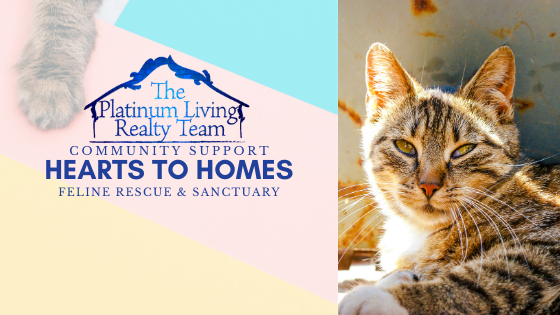January - February 2021
As you likely know our team has heart and the initiative, we are highlighting is very close to our hearts! Hearts to Homes Feline Rescue and Sanctuary is a very special non-profit that assists felines in Brantford and Brant County. I recently had a very educational conversation with Pat Kawamoto, Chairman & Managing Director of this caring group of residents who care for homeless cats. One of the most surprising things I learned from this conversation is that felines are not a native species, therefore they are not adapted to our climate and can suffer frost bite and hypothermia. See the complete interview at ParisRealEstateNews.CA. where we have included a link to their website where you can learn more or donate to this worthy cause.
Tysoski: Thank you for taking the time to talk with me about the Hearts to Homes Feline Rescue and Sanctuary, I think it’s important to know about local initiatives that improve our community in Brant County and Brantford.
Kawamoto: I’m happy to be here representing Hearts to Homes and thank you for inviting us to tell you about some of the things our group is doing to help homeless felines.
Tysoski: Pat, would you tell me a bit about our community cat population? I understand there is quite a large population of stray and feral felines in Brant County and Brantford.
Kawamoto: Yes, it may surprise many to hear that past studies indicate the homeless and feral feline population is close to 70,000 cats living on their own or in colonies. There are actually not even enough homes in our community to provide homes for the population as it is right now.
Tysoski: I’m sure most would agree that's a very big and surprising number.
Kawamoto: When we look at the cycle, we see a combination of things that are happening. Families failing to spay and neuter their cats is a contributing factor. All pet owners need to be responsible for their pets and have them spayed or neutered and the earliest possible time. If a pet is in heat, keep it secure so there is no chance for unwanted litters. A great thing to know is the spaying and neutering your pet and the appropriate age will actually prevent many very serious future health issues.
Tysoski: Where is the breakdown happening? Why are so many people not having their cats spayed or neutered?
Kawamoto: Cost is the most likely issue for many families. It can be costly to take your cat to a vet, and we understand that the resources may not be available to some families. The families that can do so really need to avoid accidental litters. This is so very important. One night your cat escapes can result in up to 4 or 5 new kittens that need homes. Families or individuals who are not realistically able to afford it, can look at affordable payment plans or look for assistance to have their pets spayed or neutered. Then there is the issue of the homeless cats who do not have a person to care for them. The TnR – Trap Neuter and Release program is the best way to manage and even reduce the population.
Tysoski: Is there a solution to this overpopulation?
Kawamoto: Great question. The simple, and complicated answer is yes, there is a way to control and reduce the population of felines in a manageable and sustainable way. There are several major examples we can follow. Two of note are Walt Disney World and Harvard. All three had a problem of stray cats, their solution was not to trap and euthanize, their solution was to trap neuter and release. When we do that the population naturally balances out. The bottom line is we need to address the reproduction, not the population. This strategy is proven to reduce populations as much as 85%. When we follow this model, it’s less expensive, less strain on the municipality and there are many fewer felines suffering. Many people do not know that domestic cats are not native to this area and are not naturally equipped for living in our climate. The do suffer in the cold.
Tysoski: What is the best way people can help with this?
Kawamoto: Get your pets spayed and neutered is the first step. If you need assistance to do this, contact your local veterinarian to see what resources are available in your area. Contact the local shelter or SPCA and make it a priority not to allow your pets to have litters that may lead to unwanted and stray felines. The second step is to champion your neighbourhood. Be part of the solution if you have friends, family or neighbours who need assistance with their pets. If you know of strays in your neighbourhood help by assisting in spaying and neutering. Every little bit helps and is preventative.
Tysoski: Great advice here, start by spaying and neutering your pets. I love the idea of being a neighbourhood champion! Thank you again for your time and sharing a bit about Hearts to Homes.
For anyone who would like to know more about Hearts to Homes, adopt a feline or make a donation to this important initiative please visit HeartsToHomes.CA
As you likely know our team has heart and the initiative, we are highlighting is very close to our hearts! Hearts to Homes Feline Rescue and Sanctuary is a very special non-profit that assists felines in Brantford and Brant County. I recently had a very educational conversation with Pat Kawamoto, Chairman & Managing Director of this caring group of residents who care for homeless cats. One of the most surprising things I learned from this conversation is that felines are not a native species, therefore they are not adapted to our climate and can suffer frost bite and hypothermia. See the complete interview at ParisRealEstateNews.CA. where we have included a link to their website where you can learn more or donate to this worthy cause.
Tysoski: Thank you for taking the time to talk with me about the Hearts to Homes Feline Rescue and Sanctuary, I think it’s important to know about local initiatives that improve our community in Brant County and Brantford.
Kawamoto: I’m happy to be here representing Hearts to Homes and thank you for inviting us to tell you about some of the things our group is doing to help homeless felines.
Tysoski: Pat, would you tell me a bit about our community cat population? I understand there is quite a large population of stray and feral felines in Brant County and Brantford.
Kawamoto: Yes, it may surprise many to hear that past studies indicate the homeless and feral feline population is close to 70,000 cats living on their own or in colonies. There are actually not even enough homes in our community to provide homes for the population as it is right now.
Tysoski: I’m sure most would agree that's a very big and surprising number.
Kawamoto: When we look at the cycle, we see a combination of things that are happening. Families failing to spay and neuter their cats is a contributing factor. All pet owners need to be responsible for their pets and have them spayed or neutered and the earliest possible time. If a pet is in heat, keep it secure so there is no chance for unwanted litters. A great thing to know is the spaying and neutering your pet and the appropriate age will actually prevent many very serious future health issues.
Tysoski: Where is the breakdown happening? Why are so many people not having their cats spayed or neutered?
Kawamoto: Cost is the most likely issue for many families. It can be costly to take your cat to a vet, and we understand that the resources may not be available to some families. The families that can do so really need to avoid accidental litters. This is so very important. One night your cat escapes can result in up to 4 or 5 new kittens that need homes. Families or individuals who are not realistically able to afford it, can look at affordable payment plans or look for assistance to have their pets spayed or neutered. Then there is the issue of the homeless cats who do not have a person to care for them. The TnR – Trap Neuter and Release program is the best way to manage and even reduce the population.
Tysoski: Is there a solution to this overpopulation?
Kawamoto: Great question. The simple, and complicated answer is yes, there is a way to control and reduce the population of felines in a manageable and sustainable way. There are several major examples we can follow. Two of note are Walt Disney World and Harvard. All three had a problem of stray cats, their solution was not to trap and euthanize, their solution was to trap neuter and release. When we do that the population naturally balances out. The bottom line is we need to address the reproduction, not the population. This strategy is proven to reduce populations as much as 85%. When we follow this model, it’s less expensive, less strain on the municipality and there are many fewer felines suffering. Many people do not know that domestic cats are not native to this area and are not naturally equipped for living in our climate. The do suffer in the cold.
Tysoski: What is the best way people can help with this?
Kawamoto: Get your pets spayed and neutered is the first step. If you need assistance to do this, contact your local veterinarian to see what resources are available in your area. Contact the local shelter or SPCA and make it a priority not to allow your pets to have litters that may lead to unwanted and stray felines. The second step is to champion your neighbourhood. Be part of the solution if you have friends, family or neighbours who need assistance with their pets. If you know of strays in your neighbourhood help by assisting in spaying and neutering. Every little bit helps and is preventative.
Tysoski: Great advice here, start by spaying and neutering your pets. I love the idea of being a neighbourhood champion! Thank you again for your time and sharing a bit about Hearts to Homes.
For anyone who would like to know more about Hearts to Homes, adopt a feline or make a donation to this important initiative please visit HeartsToHomes.CA
Categories:
Community Events
We would like to hear from you! If you have any questions, please do not hesitate to contact us. We are always looking forward to hearing from you! We will do our best to reply to you within 24 hours !

